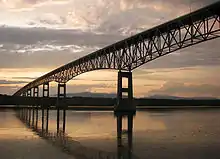Kingston–Rhinecliff Bridge
The George Clinton Kingston–Rhinecliff Bridge is a continuous under-deck truss toll bridge that carries NY 199 across the Hudson River in New York State north of the City of Kingston and the hamlet of Rhinecliff. It was opened to traffic on February 2, 1957 as a two-lane (one in each direction) bridge, although it was not actually complete. Formal opening was May 11, 1957. The original cost was $17.5 million.[1]

George Clinton Kingston–Rhinecliff Bridge | |
|---|---|
 | |
| Coordinates | 41.9776°N 73.94625°W |
| Carries | Two lanes of |
| Crosses | Hudson River |
| Locale | Kingston, New York, Rhinecliff, New York |
| Official name | George Clinton Kingston–Rhinecliff Bridge |
| Maintained by | New York State Bridge Authority |
| Characteristics | |
| Design | Continuous under-deck truss bridge |
| Total length | 7,793 ft (2375 m) |
| Width | 2 lanes with shoulders |
| Longest span | 2 x 800 ft (244 m) |
| Clearance below | 152 ft (76 m) above river |
| History | |
| Opened | February 2, 1957 |
| Statistics | |
| Toll | (eastbound only) passenger cars $1.75 cash, $1.35 E-ZPass |
| Location | |

| |
The bridge, owned by the New York State Bridge Authority (NYSBA), carries two lanes of traffic and approximately 17,000 vehicles per day. It was designed by David B. Steinman and the builders were Harris Structural Steel and Merritt-Chapman & Scott Corporation, and is the second northernmost, and second newest, of the 5 bridges that NYSBA owns and operates. The bridge has two main spans, since there is an east and west channel in the Hudson River at this point.
Development
Planning for a bridge in this general area to replace the ferry service, which was viewed as sporadic and unreliable, (there were no Hudson bridges for a half-hour or more drive time in either direction) began in the early 1940s. The site for the bridge, as originally proposed was between Kingston Point and downtown Rhinebeck, and the design was initially a suspension bridge almost identical in appearance to the Mid-Hudson Bridge. When the site was relocated about 3 miles (4.8 km) northward, there was no stable bedrock for anchorages, so the design was changed to a continuous under-deck truss. Construction commenced in 1954. When the Newburgh-Beacon Bridge was proposed, provisions were inserted in the enabling legislation that construction on that bridge could not commence until the Kingston–Rhinecliff was completed.

Like all NYSBA bridges, the Kingston–Rhinecliff is a toll bridge, with the toll set at $1.50 for eastbound automobiles and other 2 axle vehicles. Westbound traffic is not tolled. Originally, tolls were collected in both directions. In August 1970, the toll was abolished for westbound drivers, and at the same time, eastbound drivers saw their tolls doubled. The tolls of eleven other New York–New Jersey and Hudson River crossings along a 130-mile (210 km) stretch, from the Outerbridge Crossing in the south to the Rip Van Winkle Bridge in the north, were also changed to eastbound-only at that time.[2]
In 2000 the state ceremonially renamed the bridge after George Clinton, New York's first Governor, fourth Vice President of the United States and a resident of the Hudson Valley.[1]
In late 2019, a pedestrian path was added to the bridge. It is 4 feet wide, separated from traffic by a 3-foot-high barrier. The path is part of the Empire State Trail project. The path is on the south side of the bridge, next to eastbound traffic. It is for pedestrians only; bicyclists on the span will continue to be required to use the shoulders of the road.
Tolls
Tolls increased on May 1, 2020 to $1.75 cash, $1.35 E-ZPass for passenger cars. No toll is collected for westbound traffic.
References
- New York State Bridge Authority. Highland, NY. "The 'George Clinton' Kingston-Rhinecliff Bridge." Accessed 2017-11-08.
- Moran, Nancy (August 13, 1970). "One‐Way Tolls Confusing Some Drivers". The New York Times. Retrieved April 9, 2018.
External links
| Wikimedia Commons has media related to Kingston–Rhinecliff Bridge. |
- NYCroads: Historic overview
- Toll schedule - NYSBA
- Kingston–Rhinecliff Bridge at Structurae
- Chas H. Sells rehabilitation project information
